Digital Poster
Updates in Oncologic Liver Imaging II
ISMRM & ISMRT Annual Meeting & Exhibition • 03-08 June 2023 • Toronto, ON, Canada

| Computer # | |||
|---|---|---|---|
2431.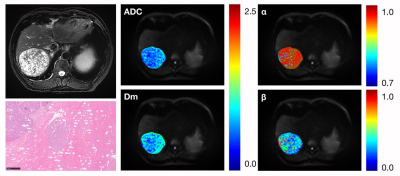 |
81 | Identifying the Microvascular Invasion of Hepatocellular Carcinoma with a Continuous Time Random-Walk Diffusion Model
Jiejun Cheng1, Dingxia Liu1, Yunfei Zhang2, Yongming Dai2, and Xiuzhong Yao1
1Shanghai Institute of Medical Imaging, Shanghai, China, 2MR Collaboration, Central Research Institute, United Imaging Healthcare, Shanghai, China Keywords: Liver, Cancer DWI is the most widely-used functional magnetic resonance imaging (MRI) technique in clinical practice. It has been widely acknowledged that DWI has the potential to probe tissue cellularity, microstructures, and microvasculature at a subvoxel-level. In this study, we aim to access the clinical application of the continuous-time random-walk (CTRW) model which recognizes intravoxel diffusion heterogeneity in both time and space in the preoperative evaluation of microvascular invasion (MVI) in hepatocellular carcinoma (HCC) patients. Our results showed that diffusion parameters derived from CTRW model can be used as noninvasive quantitative imaging markers for preoperatively predicting the MVI of HCCs. |
|
2432.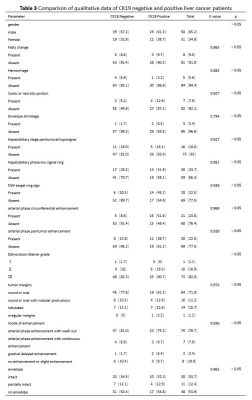 |
82 | Gadoxetic acid–enhanced MRI-based assessment of imaging features in patients with CK19-positive small hepatocellular carcinoma (≤3 cm)
Maotong Liu1, Tao Zhang1, Xue-Qin Zhang1, Lei Xu1, and Xian-ce Zhao2
1Affiliated Nantong Hospital 3 of Nantong University, Nantong, China, 2Philips Healthcare, Shanghai, China Keywords: Liver, Cancer The aim of this study was to compare the preoperative imaging findings of CK19-positive patients with HCC less than 3 cm with those of CK19-negative patients with small HCC to determine the prognosis of patients with CK19-positive small HCC after radical resection. We obtained the important predictive parameters of CK-19 positive small liver cancer patients by qualitatively and quantitatively comparing the imaging data and relevant clinical parameters of these patients before surgery. Our study showed that rim APHE in gadoxetic acid-enhanced MR imaging may help to predict early (2 years) postoperative recurrence in patients with CK19-positive small HCC. |
|
2433.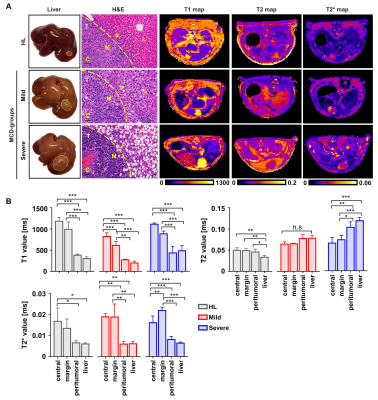 |
83 | Magnetic Resonance Imaging of the Liver Microenvironment to Assess Hepatocellular Carcinoma Growth and Characteristics in Rat
Yeon Ji Chae1, Hwon Heo1, Chul-Woong Woo2, Sang-Tae Kim2, Do-Wan Lee3, Monica Young Choi2, Yoonseok Choi4, and Dong-Cheol Woo1,2
1Department of Convergence Medicine, Asan Medical Center, University of Ulsan College of Medicine, Seoul, Korea, Republic of, 2Convergence Medicine Research Center, Asan Institute for Life Sciences, Asan Medical Center, Seoul, Korea, Republic of, 3Department of Radiology, Asan Medical Center, University of Ulsan College of Medicine, Seoul, Korea, Republic of, 4Medical Research Institute, Gangneung Asan Hospital, Gangneung-si, Gangwon-do, Korea, Republic of Keywords: Liver, Tumor, Magnetic resonance imaging, Liver microenvironment, Nonalcoholic steatohepatitis, Hepatocellular carcinoma In this study, a syngeneic orthotopic hepatocellular carcinoma (HCC) rat model with nonalcoholic steatohepatitis (NASH) was established to elucidate the role of the liver microenvironment using MRI. Our findings demonstrated that the HCC growth and progression were accelerated by the disease severity of NASH in the syngeneic orthotopic HCC rat model. This suggests that the liver microenvironment is important for HCC promotion. |
|
2434.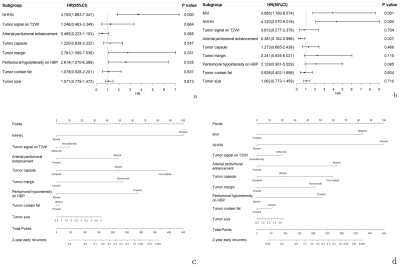 |
84 | Preoperative gadoxetic acid-enhanced MRI combined with MVI can effectively predicte early recurrence in hepatocellular carcinoma
Jiyun Zhang1, Tao Zhang1, Xueqin Zhang1, and Xiance Zhao2
1Affiliated Nantong Hospital 3 of Nantong University, Nantong, Jiangsu Province, China, 2Philips Healthcare, Shanghai, China Keywords: Liver, Tumor, early recurrence Synopsis: The purpose of this study is to determine whether preoperative gadoxetic acid-enhanced MRI combined with microvascular invasion can effectively improve the predictive efficacy of early recurrence in HCC. We retrospectively reviewed patients with HBV who underwent curative resection for HCC, analysed preoperative factors to develop a preoperative model, and analysed both preoperative factors and microvascular invasion to develop a pre-/postoperative prediction model. Our study showed that the preoperative and pre-/postoperative prediction models demonstrate good performance for predicting early recurrence, the AUC of the two prediction model better than only the MVI risk factor. |
|
2435.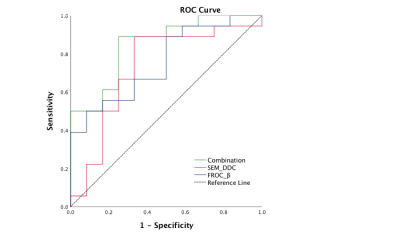 |
85 | Differentiating Benign from Malignant Liver Lesions Using Non-Gaussian Models of Diffusion Weighted MRI
Xiaojun Yang1,2, Xiaohui Duan1,2, Mengzhu Wang3, Zhuoheng Yan1,2, Huijun Hu1,2, and Jun Shen1,2
1Sun Yat-Sen Memorial Hospital, Guangzhou, China, 2Sun Yat-Sen University, Guangzhou, China, 3MR Scientific Marketing, Siemens Healthineers Ltd, Guangzhou, China Keywords: Liver, Diffusion/other diffusion imaging techniques This study aimed to evaluate the feasibility of various diffusion metrics obtained from stretched exponential model (SEM), diffusion kurtosis (DK) and fractional-order calculus (FROC) models -based diffusion-weighted imaging (DWI) in differentiating benign from malignant liver lesions. The results demonstrated that, as non-Gaussian DWI models, the combination of SEM and FROC models showed good discriminative ability, which was able to differentiate benign and malignant liver lesions. |
|
2436. |
86 | Liver lesion detection : Comparison of different flip angle and delay time
Xue Ren1, Ying Zhao1, Qingwei Song1, Zhigang Wu2, and Ailian Liu1
1The First Affiliated Hospital of Dalian Medical University, Dalian, China, 2Clinical and Technical Support, Philips Healthcare, Shenzhen, China Keywords: Liver, Liver Detection of liver lesion remains challenge since the contrast to noise ratio is always changing after intravenous bolus injection of Gd-BOPTA between lesion and liver tissue. The purpose of the study was to compare the lesion-to-liver CNR for different schemes using different flip angle and delay time. The results shows that the protocol of 60min FA10°could be used as the preferred scanning parameter, it could also be used to save the scan time. |
|
2437.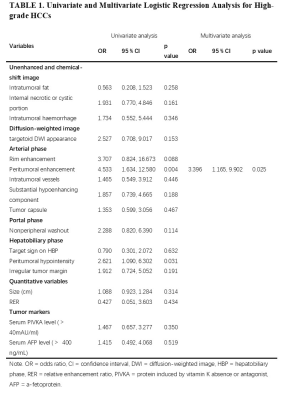 |
87 | Prediction for aggressiveness and recurrence of hepatocellular carcinoma using gadoxetic acid-enhanced magnetic resonance imaging
Mengtian Lu1, Xueqin Zhang1, Tao Zhang1, Qi Qu1, Lei Xu1, Jiyun Zhang1, Maotong Liu1, Jifeng Jiang1, Wei Shen2, and Xiance Zhao2
1Nantong Third People's Hospital, Nantong, China, 2Philips Healthcare, Nantong, China Keywords: Cancer, MR Value This study explores the predictive value of gadoxetic acid-enhanced magnetic resonance imaging (MRI) features on the pathologic grade, microvascular invasion (MVI), and cytokeratin-19 (CK19) expression in hepatocellular carcinomas (HCC), and evaluates their association with postoperative recurrence of HCC. The main method is to investigate whether there are independent predictors of the above aggressive indicators in the gadoxetic acid-enhanced MRI features and clinical parameters. Our study shows that peritumoral enhancement, peritumoral hypointensity and rim enhancement could independently predict poor pathological grade, MVI and CK19, respectively. Consequently, these results may help HCC patients develop more appropriate treatment options. |
|
2438.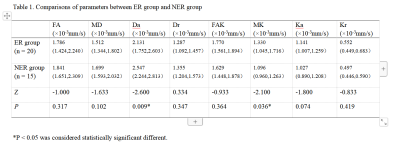 |
88 | The value of diffusion kurtosis imaging for predicting two-year early recurrence (ER) of hepatocellular carcinoma after curative resection
Yanxi Xiong1, Ying Zhao 1, Ailian Liu 1, Xue Ren1, Qihao Xu1, and Qingwei Song1
1The First Affiliated Hospital, Dalian Medical University, Dalian, China Keywords: Liver, Cancer Hepatocellular carcinoma (HCC) is viewed as the most frequent primary liver cancer and the third cause of cancer related death worldwide [1]. The 5-year overall survival rate is only 30–40% after surgical resection and 70% of patients have a tumor recurrence within 5 years [2]. we evaluated the discrimination power of Diffusion Kurtosis Imaging for predicting two-year early recurrence (ER) of hepatocellular carcinoma (HCC) after curative resection.Our resuts showed that DKI-based quantitative parameters might have acertain value inpredicting two-year early recurrence (ER) in HCC. |
|
2439.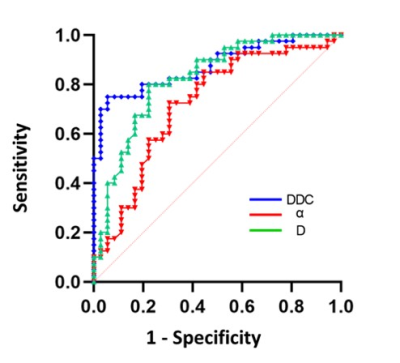 |
89 | Values of stretched exponential model and fractional order calculus model in predicting microvascular invasion in hepatocellular carcinoma
Jinhuan Xie1, Liling Long1, Chenhui Li1, and Huiting Zhang2
1The First Affiliated Hospital of Guangxi Medical University, Nanning, China, 2Siemens Healthineers, Wuhan, China Keywords: Liver, Diffusion/other diffusion imaging techniques This study aimed to evaluate the potential value of stretched exponential model (SEM) and fractional order calculus (FROC) diffusion model in predicting microvascular invasion (MVI) in hepatocellular carcinoma (HCC) before surgery. Our results showed that compared with MVI-negative group, MVI-positive group had significant lower DDC from SEM and D from FROC and significant higher α from SEM. DDC had the best diagnostic performance for MVI, D was next, and α was last. SEM and FROC models can predict the MVI of HCC, and the DDC, α, and D values were potential biomarkers in future clinical practice. |
|
2440.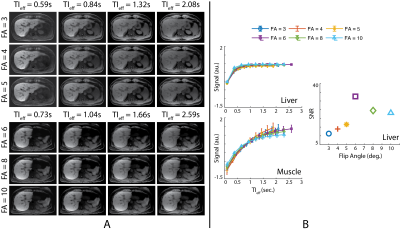 |
90 | Free-Breathing, Gadoxetic Acid Enhanced, 3D T1w Phase Sensitive Inversion Recovery Hepatobiliary MRI Optimized for 3.0 Tesla
Yavuz Muslu1,2, Ty A. Cashen3, Sagar Mandava4, Diego Hernando2,5, and Scott B. Reeder1,2,5,6,7
1Department of Biomedical Engineering, University of Wisconsin-Madison, Madison, WI, United States, 2Department of Radiology, University of Wisconsin-Madison, Madison, WI, United States, 3Global MR Applications and Workflow, GE Healthcare, Waukesha, WI, United States, 4Global MR Applications and Workflow, GE Healthcare, Atlanta, GA, United States, 5Department of Medical Physics, University of Wisconsin-Madison, Madison, WI, United States, 6Department of Medicine, University of Wisconsin-Madison, Madison, WI, United States, 7Department of Emergency Medicine, University of Wisconsin-Madison, Madison, WI, United States Keywords: Liver, Image Reconstruction Gadoxetic acid (GA)-enhanced hepatobiliary phase (HBP) T1-weighted (T1w) MRI is well established for the detection of focal liver lesions. Previously, we proposed a novel imaging method to improve T1 contrast in GA-enhanced HBP T1w images for the purpose of improved detection and characterization of liver lesions. The proposed method provides volumetric, high-resolution phase-sensitive inversion recovery (PSIR) T1w images of the liver from a free-breathing image acquisition. This study focuses on the impact of flip angle and spoiling on image quality. Our findings indicate 6-8 degrees flip angle in combination with gradient spoiling provides optimal image quality and T1 contrast. |
|
2441.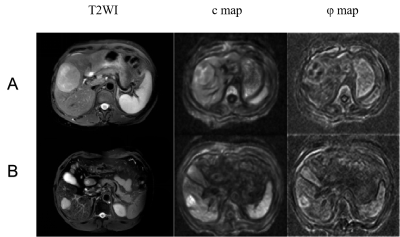 |
91 | Tumor-liver biomechanical interaction investigated by multifrequency MR elastography in patients with HCC
Jiahao Zhou1, Ruokun Li2, Jing Guo3, Ingolf Sack3, and Fuhua Yan2
1Ruijin Hospital, Shanghai Jiaotong University School of Medicine, Shanhai, China, 2Ruijin Hospital, Shanghai Jiaotong University School of Medicine, Shanghai, China, 3Department of Radiology, Charité–Universitätsmedizin Berlin, Berlin, Germany;Charitéplatz 1, 10117 Berlin, Germany, Berlin, Germany Keywords: Liver, Cancer Tumor-liver biomechanical interaction investigated by multifrequency MR elastography in patients with HCC |
|
2442.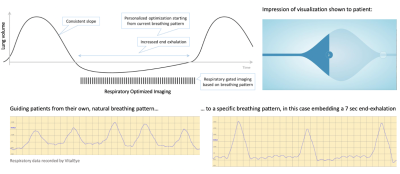 |
92 | Active Breathing Guidance for T2-weighted liver MRI sequences: a novel in-bore solution for image quality and efficiency improvement
Narine Mesropyan1, Christoph Katemann2, Annerieke Heuvelink-Marck2, Alexander Isaak1, Dmitrij Kravchenko1, Leon Bischoff1, Ad Denissen2, Claus Christian Pieper1, Daniel Kuetting 1, Ulrike Attenberger1, and Julian Luetkens1
1Department of Diagnostic and Interventional Radiology, University Hospital Bonn, Bonn, Germany, 2Philips Healthcare, Philips Healthcare, Hamburg, Germany Keywords: Liver, Artifacts Breathing artifacts in liver MRI lead to impaired image quality, decreased diagnostic confidence, and, as a consequence, longer acquisition times or repetitive examinations. To improve the image quality and scan efficiency we integrated a newly developed in-bore breathing guidance application for T2 weighted sequences with propeller acquisition (MultiVaneXD) (T2BG) and compared it to a conventional free-breathing acquisition method (T2conv). Our study results suggest that an active breathing guidance for T2w liver MRI sequences significantly reduces breathing artifacts and total scan times by 21% while maintaining high image quality. |
|
2443.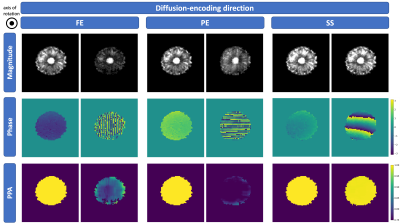 |
93 | On Intra-Voxel Dephasing in Liver Diffusion-Weighted Imaging
Johannes Raspe1, Sean McTavish1, Kilian Weiss2, Johannes M. Peeters3, Dimitrios C. Karampinos1, and Anh T. Van1
1Department of Diagnostic and Interventional Radiology, School of Medicine, Klinikum rechts der Isar, Technical University of Munich, Munich, Germany, 2Philips GmbH Market DACH, Hamburg, Germany, 3Philips Healthcare, Eindhoven, Netherlands Keywords: Liver, Diffusion/other diffusion imaging techniques Motion is a major source of artifacts in liver diffusion-weighted (DW) imaging leading to severe signal loss. Physical information about motion is encoded in the phase of DW images based on a pulsed gradient spin-echo (PGSE) sequence. The present work proposes a methodology to estimate a phase-predicted attenuation (PPA) which correlates with the magnitude variation of DW images in motion-controlled phantom experiments and in vivo measurements. These phase-based predictions allow to isolate motion-related magnitude attenuation for further investigation of undesired signal loss effects and offer potential for refining algorithms to reduce magnitude loss in DW imaging of the liver. |
|
2444.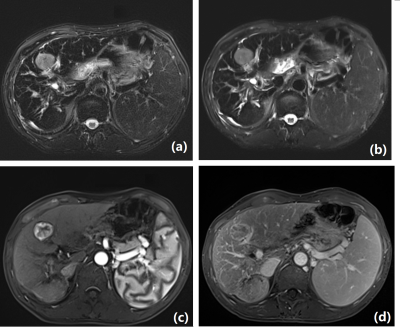 |
94 | Deep learning–accelerated HASTE for single breath-hold liver T2-weighted imaging
Kai Liu1, Caixia Fu2, Dominik Nickel3, Caizhong Chen1, Haitao Sun1, and Mengsu Zeng1
1Radiology, Zhongshan Hospital, Fudan University, Shanghai, China, 2MR Collaboration, Siemens (Shenzhen) Magnetic Resonance Ltd., Shenzhen, China, 3MR Application Predevelopment, Siemens Healthcare GmbH, Erlangen, Germany, Erlangen, Germany Keywords: Liver, Data Acquisition, Deep-learning reconstruction The HASTE sequence accelerated by deep learning (DL) reconstruction was used to perform liver T2-weighted imaging under a single breath-hold in a daily routine. Its image quality, including signal-to-noise ratio, contrast-to-noise ratio, artifacts, edge sharpness and slice continuity, was evaluated by comparing it with the conventional multi-breath-hold BLADE sequence. The result demonstrated that DL-accelerated HASTE could shorten the acquisition time remarkably while maintaining clinically satisfactory image quality. |
|
2445.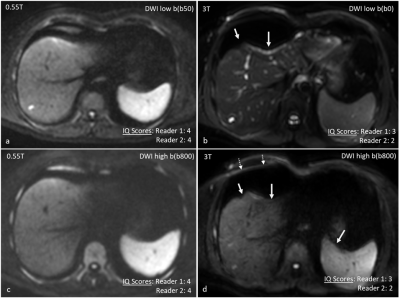 |
95 | Feasibility of Routine Abdominal MR Imaging in Patients at 0.55T: Comparison with 1.5 and 3T
Anupama Ramachandran1, Nicole Seiberlich1, Katherine Wright2, Jacob Richardson2, Nancy Dudek2, Joel Morehouse2, Mishal Mendiratta Lala2, Vikas Gulani2, and Hero Hussain2
1Radiology, University of Michigan, Ann Arbor, MI, United States, 2University of Michigan, Ann Arbor, MI, United States Keywords: Liver, Low-Field MRI, Abdomen Abdominal MRI performed in 51 patients on a commercial 0.55T system were retrospectively and independently rated by two radiologists for diagnostic performance and image quality (IQ). Twenty-eight patients had comparison scans performed at higher field strengths. The clinical question was answered by both radiologists in all 51 cases performed at 0.55T, and the average IQ of all sequences was acceptable. In the subset of patients with comparison studies, the average IQ scores were significantly higher at 0.55T for DWI. No statistically significant difference was seen in IQ for the other sequences. Total acquisition time was almost double at 0.55T. |
|
2446.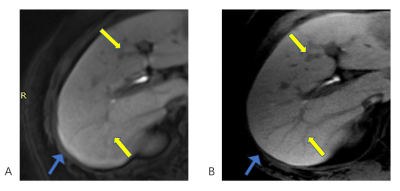 |
96 | High-resolution hepatocyte-specific phase MRI of the liver using golden-angle radial sparse parallel imaging
Lihua Chen1, Daihong Liu1, Qing Li2, and Jiuquan Zhang1
1Department of Radiology, Chongqing University Cancer Hospital, School of Medicine, Chongqing University, Chongqing, China, 2MR Collaborations, Siemens Healthineers Ltd, Shanghai, China Keywords: Liver, Liver, hepatobiliary phase Conventional abdominal MRI requires breath-holds in clinical routine which restricts acquisition times. Thus, radial MRI with additional motion compensation is desirable to further improve the performance of free-breathing abdominal exams for routine clinical use. This study aims to evaluate the feasibility of free-breathing high-resolution hepatocyte-specific phase MRI of the liver using golden-angle radial sparse parallel imaging. The results suggest that high-resolution hepatocyte-specific phase MRI with GRASP may offers a flexible alternative to assess liver lesions in patients. |
|
2447.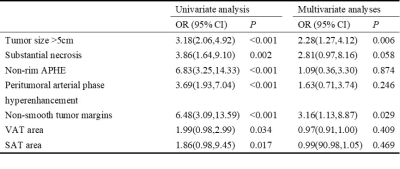 |
97 | Lower abdominal adipose result in higher postoperative early recurrence in HCC patients with HBV
Dexin Yu1, Liping Zuo1, Yueming An1, Jinlei Fan1, and Bowen Wang1
1Qilu Hospital of Shandong University, Jinan, China Keywords: Liver, Cancer Problem: To investigate the incremental value of abdominal adipose to identify postoperative early recurrence in hepatitis B virus (HBV) patients with hepatocellular carcinoma (HCC). Methods: Visceral adipose tissue (VAT) and subcutaneous adipose tissue (SAT) areas were measured in the third lumbar vertebra plane of T1-weighted images. Results: HCC with microvascular invasion, portal invasion, and satellite nodules patients had lower VAT and SAT areas. VAT and SAT areas were important risk factors for early recurrence. Conclusions: Decreased VAT and SAT areas have significant impact regarding the postoperative early recurrence and poorer HCC biological behavior in HBV patients with HCC. |
|
2448.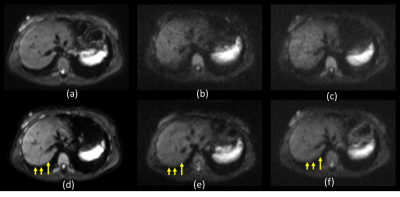 |
98 | Multi-shot Abdomen Diffusion Imaging using external navigators with volume coil
Ashok Kumar P Reddy1, Nitin Jain1, Harsh Agarwal1, Rajdeep Das1, Rajagopalan Sundaresan1, Sajith Rajamani1, Arnaud Guidon2, Ramanna Sudhir1, Yang Baolian2, Merry Mani3, M Ramasubba Reddy4, and Ramesh Venkatesan1
1Engineering, Wipro GE HealthCare, Bangalore, India, 2GE HealthCare, Waukesha, WI, United States, 3University of Iowa, Iowa, IA, United States, 4IIT Madras, Chennai, India Keywords: Liver, Body Diffusion MRI in liver is key to detecting liver pathology. However, diffusion in abdomen is limited by its inability to use multi-channel surface coil for obese liver patients. Here we present a novel use of external gradient echo and spin echo navigators for diffusion imaging with a single channel volume coil for providing distortion less diffusion images. We also extend and demonstrate this technique on multichannel coil for Diffusion in Brain. |
|
2449.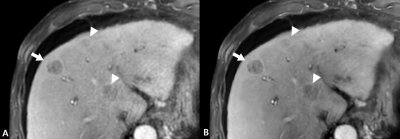 |
99 | De-streaking effect Deep Learning Reconstruction in free-breathing dynamic contrast enhanced Liver MRI
Eun Joo Park1, Yedaun Lee1, Ho Joon Lee1, Jisook Yi1, Joonsung Lee2, Xinzeng Wang3, and Arnaud Guidon4
1Department of Radiology, Haeundae Paik Hospital, Inje University College of Medicine, Busan, Korea, Republic of, 2GE Healthcare, Seoul, Korea, Republic of, 3GE Healthcare, Houston, TX, United States, 4GE Healthcare, Boston, MA, United States Keywords: Liver, Liver In dynamic contrast enhanced (DCE) liver MRI, fast image acquisition with free breathing comes in expense of artifacts and noise, the most notably streak artifacts. In our study, we evaluated de-streaking effect and image quality of free-breathing stack of star liver MRI acquisition with deep learning reconstruction. Application of deep learning reconstruction (DLR) provides improved image quality by removing streak artifact and noise in liver MR images. |
|
2450.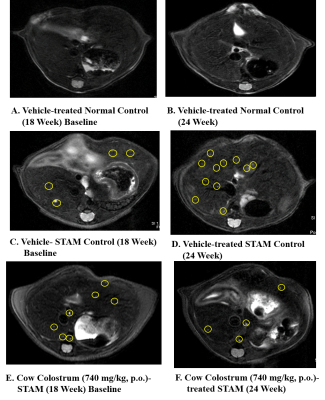 |
100 | Cow Colostrum Regresses STAM-induced Non-alcoholic Steatohepatitis-associated Hepatocellular Carcinoma in Mice
Uma Sharma1, Sangeetha Gupta2, Ritu Tyagi1, Bhavya Dhawan2, and Ankit Shokeen2
1Department of Nuclear Magnetic Resonance, All India Institute of Medical Sciences, New Delhi, NEW DELHI, India, 2Amity Institute of Pharmacy (AIP), Amity University Uttar Pradesh, Noida Campus, Noida, India Keywords: Liver, Cancer, MRI, Steatohepatitis-associated Hepatocellular Carcinoma, cow colustrum, therapy Nutraceuticals is an emerging industry with the potential to cater the needs of many therapeutic domains, including cancer a major cause of health concerns. Despite the currently available therapeutics, complication and effective medical management of HCC, particularly at an advanced stage has several limitations. Hence, in the present study an alternative approach using an animal product cow colostrum as therapeutics for HCC is explored in STAM-induced non-alcoholic steatohepatitis-associated hepatocellular carcinoma in mice. If successful this might prove to be a very viable and effective management for NASH-associated HCC. |
|
The International Society for Magnetic Resonance in Medicine is accredited by the Accreditation Council for Continuing Medical Education to provide continuing medical education for physicians.